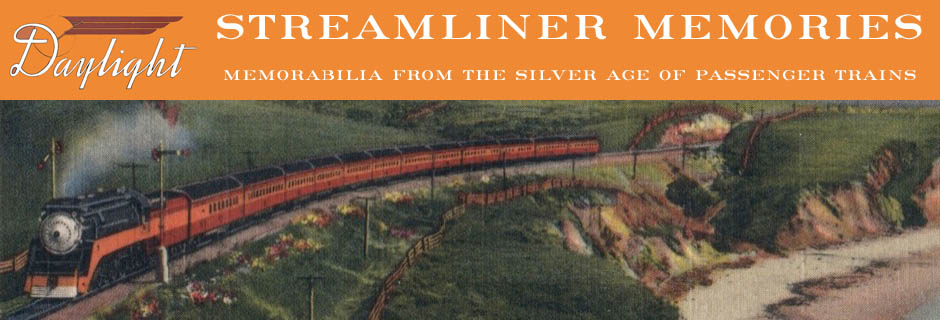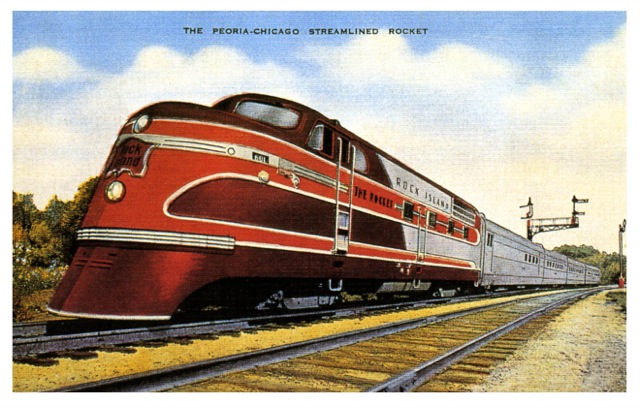The 1938 Report on Streamline Trains discusses several streamlined trains that I haven’t mentioned in previous posts, and while I don’t have a lot of memorabilia for these trains they are worth presenting for the sake of completeness. The first are the Rock Island Rockets, which were transitional trains between the early Burlington Zephyrs and later full-sized streamliners such as the Santa Fe Super Chief.
Inaugurated in 1937, the rockets consisted of three- and four-car Budd-built articulated trains, similar to the original Zephyr, but without an articulated power car. Instead, the Rockets were powered by a unique (in the sense that no other railroad had one) General Motors Diesel called the TA. The TAs–the T stood for twelve as in 1,200 horsepower–were 60 feet long, compared with General Motors’ E units, which were 70 feet long. While the Es each had two 900-HP, V-12 Diesel engines, the TAs had one 1,200-HP, V-16 engine, the same engine used in some of the Zephyr and City trains. The last, observation car was also non-articulated.
Click to download a PDF of the front and back of this postcard. This scene is imaginary, as the main Rocky Mountain Rocket train never came within sight of Pikes Peak, and the Colorado Springs branch of the Rocket used a different locomotive.
Initially, there were five rocket routes: Chicago-Peoria; Chicago-Des Moines; Ft. Worth-Houston; Kansas City-Minneapolis; and Kansas City-Denver, which was soon changed to Kansas City-Oklahoma City. The Chicago-Denver/Colorado Springs Rocky Mountain Rocket overnight train would be added in 1939.
The Rocky Mountain Rocket used another unique locomotive called an AB6. Between Chicago and Limon, Colorado, this served as a booster unit to the E6 that led the train, then separated and became a flat-faced cab unit for the segment of the train going to Colorado Springs.
The Fort Worth-Houston Texas Rocket used the same route as the Sam Houston Zephyr on tracks shared by the two railroads. Ignoring the Fort Worth-Dallas portion of the trip, they made the same trip in four hours (with three stops) that the Southern Pacific Sunbeam made in four hours and twenty-five minutes (with only two stops). Though the Sunbeam was a much larger train–280 revenue seats vs. about 120 for the Zephyr/Rocket–it had a much lower ridership and was much less profitable than either of the other two.
The Peoria, Des Moines, and Minneapolis rockets share with the Hiawatha the distinction of being the only trains in the Report on Streamline Trains to earn a profit in their dining-car operations. The Peoria Rocket only netted $139 over the course of a year, while the other two netted about $2,000 to $4,000. But that’s pretty amazing when the Denver Zephyr lost $50,000; the City of Denver lost $34,000; and the Santa Fe (which contracted dining car services out to Fred Harvey) lost $17,000 on the Super Chief/El Capitan. Meanwhile, the Hiawatha netted close to $12,000.
Rock Island publicity photo showing the dining car of a Rocket Train in 1951.
I’ve never analyzed dining car operations, but I suspect that two reasons why they typically lose money are that the cost of providing food service on cramped, moving trains is higher than in large stationary restaurants and the potential customer base is limited to those who are on board the trains instead of anyone who might walk or drive by.
By virtue of having one of the largest trains in the book (with an expandable minimum of nearly 300 revenue seats vs. 100 to 200 for most other streamlined trains) and having the highest occupancy rate (73 percent vs. an average of less than 50 percent for other trains), the Hiawatha has one of the largest customer bases. But that doesn’t explain why the relatively tiny rockets, with 128 to 177 revenue seats, could earn a profit on dining. Considering that Amtrak is currently under fire for losing money on its dining car operations, it’s too bad we can’t consult someone from the Rock Island or Milwaukee Road today to find out.




I have seen a reference on another site (http://traintalkbloggers.wordpress.com/2009/03/09/strombecker-rock-island-rocket/) that one of the Rockets was in fact originally assigned to a Kansas City-Denver run, then later pulled and reassigned to the Kansas City-Oklahoma City service with the cars renamed appropriately. So it appears that Wikipedia does have it right, although the article is incomplete. I don’t yet have a timetable or other reference for late 1937 or very early 1938, but I’m keeping my eyes open. Eventually I’d like to post timetables for all of the original Rockets.
Where is the steam engine today and can people see it?